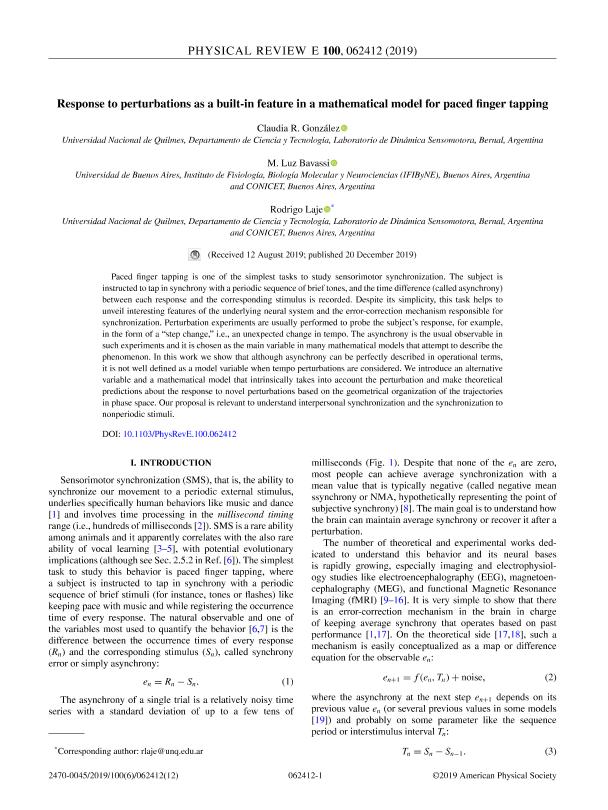Artículo
Response to perturbations as a built-in feature in a mathematical model for paced finger tapping
Fecha de publicación:
12/2019
Editorial:
American Physical Society
Revista:
Physical Review E
ISSN:
2470-0045
Idioma:
Inglés
Tipo de recurso:
Artículo publicado
Clasificación temática:
Resumen
Paced finger tapping is one of the simplest tasks to study sensorimotor synchronization. The subject is instructed to tap in synchrony with a periodic sequence of brief tones, and the time difference (called asynchrony) between each response and the corresponding stimulus is recorded. Despite its simplicity, this task helps to unveil interesting features of the underlying neural system and the error-correction mechanism responsible for synchronization. Perturbation experiments are usually performed to probe the subject´s response, for example, in the form of a step change, i.e., an unexpected change in tempo. The asynchrony is the usual observable in such experiments and it is chosen as the main variable in many mathematical models that attempt to describe the phenomenon. In this work we show that although asynchrony can be perfectly described in operational terms, it is not well defined as a model variable when tempo perturbations are considered. We introduce an alternative variable and a mathematical model that intrinsically takes into account the perturbation and make theoretical predictions about the response to novel perturbations based on the geometrical organization of the trajectories in phase space. Our proposal is relevant to understand interpersonal synchronization and the synchronization to nonperiodic stimuli.
Archivos asociados
Licencia
Identificadores
Colecciones
Articulos(IFIBYNE)
Articulos de INST.DE FISIOL., BIOL.MOLECULAR Y NEUROCIENCIAS
Articulos de INST.DE FISIOL., BIOL.MOLECULAR Y NEUROCIENCIAS
Articulos(SEDE CENTRAL)
Articulos de SEDE CENTRAL
Articulos de SEDE CENTRAL
Citación
González, Claudia Roxana; Bavassi, Mariana Luz; Laje, Rodrigo; Response to perturbations as a built-in feature in a mathematical model for paced finger tapping; American Physical Society; Physical Review E; 100; 6; 12-2019; 62412-62412
Compartir
Altmétricas




